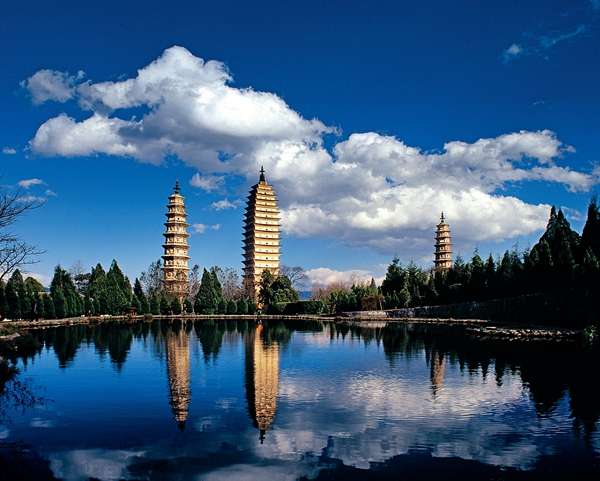Dali: A Charming Folk City
China Today,January 11, 2018 Adjust font size:
Kingdom in Martial Arts Fictions
Many people first know about the Kingdom of Dali through a martial arts fiction by Jin Yong (Louis Cha), a famous Chinese martial arts novelist. The leading man in Jin’s representative work Demi-Gods and Semi-Devils is a prince of Dali Kingdom, Duan Yu, who succeeded to the throne. In history, there was a king of Dali Kingdom, whose name is Duan Heyu.
Three Pagodas of the Chongsheng Temple.
The history of the Dali Kingdom dates back to 937, when the Duan family first established the kingdom. They adopted today’s Dali Old Town as its capital just as the previous Nanzhao Kingdom did. The Dali Kingdom had 22 kings in its 316 years of history. In 1253, Kublai Khan (1215-1294) led the Mongolian army to wipe out the Dali Kingdom. This marked a turning point for Dali as it signified the end of the era when Dali served as a political, economic, and cultural center of Yunnan. Since then, Kunming, today’s capital of the province, has become the political center of Yunnan.
What stands out most in Jin Yong’s novel about Dali is the Tianlong (Heavenly Dragon) Temple and vast areas of camellia flowers.
The Tianlong Temple in the novel is a royal temple of the Dali Kingdom. Many abdicated kings became monks and practiced martial arts here. The book stated that the temple is located north of the Cangshan Mountain. Its official name is Chongsheng, but local residents are now used to calling it Tianlong Temple.
Since Yunnan Province is geographically close to Southeast Asian countries, Buddhism was prevalent in the Dali Kingdom. Many time-honored Buddhist temples, pagodas, and sculptures are still found in the region today. The Chongsheng Temple was a center for Buddhist activities during the kingdom’s era. Among the total 22 kings of Dali, nine became monks after their abdication. A king of Myanmar visited Chongsheng Temple twice. However, in the mid-19th century, the temple was destroyed in a big fire, and only three pagodas survived, which have come to be known as the Three Pagodas of Chongsheng Temple.
In Jin Yong’s novel, Duan Yu spoke highly of camellia flowers in Dali, which has aroused the readers’ interest to see them with their own eyes.
The camellia, popularized by a French book, in fact originated in China, and Dali is one of its hometowns. The camellia flowers in Dali are big in shape and bright in color. As early as 1,500 years ago, local people started cultivating this plant. The royal court of the Dali Kingdom considered the camellia as the “emperor’s flower.” In the seventh century, camellia spread to other areas of Asia through Japan and other neighboring countries. In the 18th century, it spread to Europe and America. Today, people in Dali still have the tradition of growing camellias. When spring comes, the camellia flowers on mountains and family yards blossom, making Dali a brightly-colored world of flowers.
